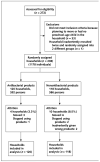Effect of antibacterial home cleaning and handwashing products on infectious disease symptoms: a randomized, double-blind trial
- PMID: 14996673
- PMCID: PMC2082058
- DOI: 10.7326/0003-4819-140-5-200403020-00007
Effect of antibacterial home cleaning and handwashing products on infectious disease symptoms: a randomized, double-blind trial
Abstract
Background: Despite the widespread household use of cleaning and personal hygiene products containing antibacterial ingredients, their effects on the incidence of infectious disease symptoms have not been studied.
Objective: To evaluate the effect of antibacterial cleaning and handwashing products for consumers on the occurrence of infectious disease symptoms in households.
Design: Randomized, double-blind clinical trial.
Setting: Northern Manhattan inner-city neighborhood, New York.
Participants: 238 primarily Hispanic households (1178 persons) that included at least one preschool-age child.
Interventions: Households were randomly assigned to use either antibacterial or nonantibacterial products for general cleaning, laundry, and handwashing. All products were commercially available, but the packaging was blinded and the products were provided free to participants.
Measurements: Hygiene practices and infectious disease symptoms were monitored by weekly telephone calls, monthly home visits, and quarterly interviews for 48 weeks.
Results: Symptoms were primarily respiratory: During 26.2% (717 of 2736) of household-months, 23.3% (640 of 2737) of household-months, and 10.2% (278 of 2737) of household-months, one or more members of the household had a runny nose, cough, or sore throat, respectively. Fever was present during 11% (301 of 2737) of household-months, vomiting was present in 2.2% (61 of 2737), diarrhea was present in 2.5% (69 of 2737), and boils or conjunctivitis were present in 0.77% (21 of 2737). Differences between intervention and control groups were not significant for any symptoms (all unadjusted and adjusted relative risks included 1.0) or for numbers of symptoms (overall incidence density ratio, 0.96 [95% CI, 0.82 to 1.12]).
Conclusions: The tested antibacterial products did not reduce the risk for symptoms of viral infectious diseases in households that included essentially healthy persons. This does not preclude the potential contribution of these products to reducing symptoms of bacterial diseases in the home.
Figures


Comment in
-
Beyond Semmelweis: moving infection control into the community.Ann Intern Med. 2004 Mar 2;140(5):397-8. doi: 10.7326/0003-4819-140-5-200403020-00016. Ann Intern Med. 2004. PMID: 14996682 No abstract available.
-
Summaries for patients. Use of household cleaning products with antibacterial ingredients did not reduce symptoms of infection.Ann Intern Med. 2004 Mar 2;140(5):I30. doi: 10.7326/0003-4819-140-5-200403020-00001. Ann Intern Med. 2004. PMID: 14996691 No abstract available.
References
-
- Dennehy PH. Transmission of rotavirus and other enteric pathogens in the home. Pediatr Infect Dis J. 2000;19:S103–5. - PubMed
-
- Scott E. Relationship between cross-contamination and the transmission of foodborne pathogens in the home. Pediatr Infect Dis J. 2000;19:S111–3. - PubMed
-
- Goldmann DA. Transmission of viral respiratory infections in the home. Pediatr Infect Dis J. 2000;19:S97–102. - PubMed
-
- Aiello AE, Larson EL. What is the evidence for a causal link between hygiene and infections? Lancet Infect Dis. 2002;2:103–10. - PubMed
Publication types
MeSH terms
Substances
Grants and funding
LinkOut - more resources
Full Text Sources
Medical
